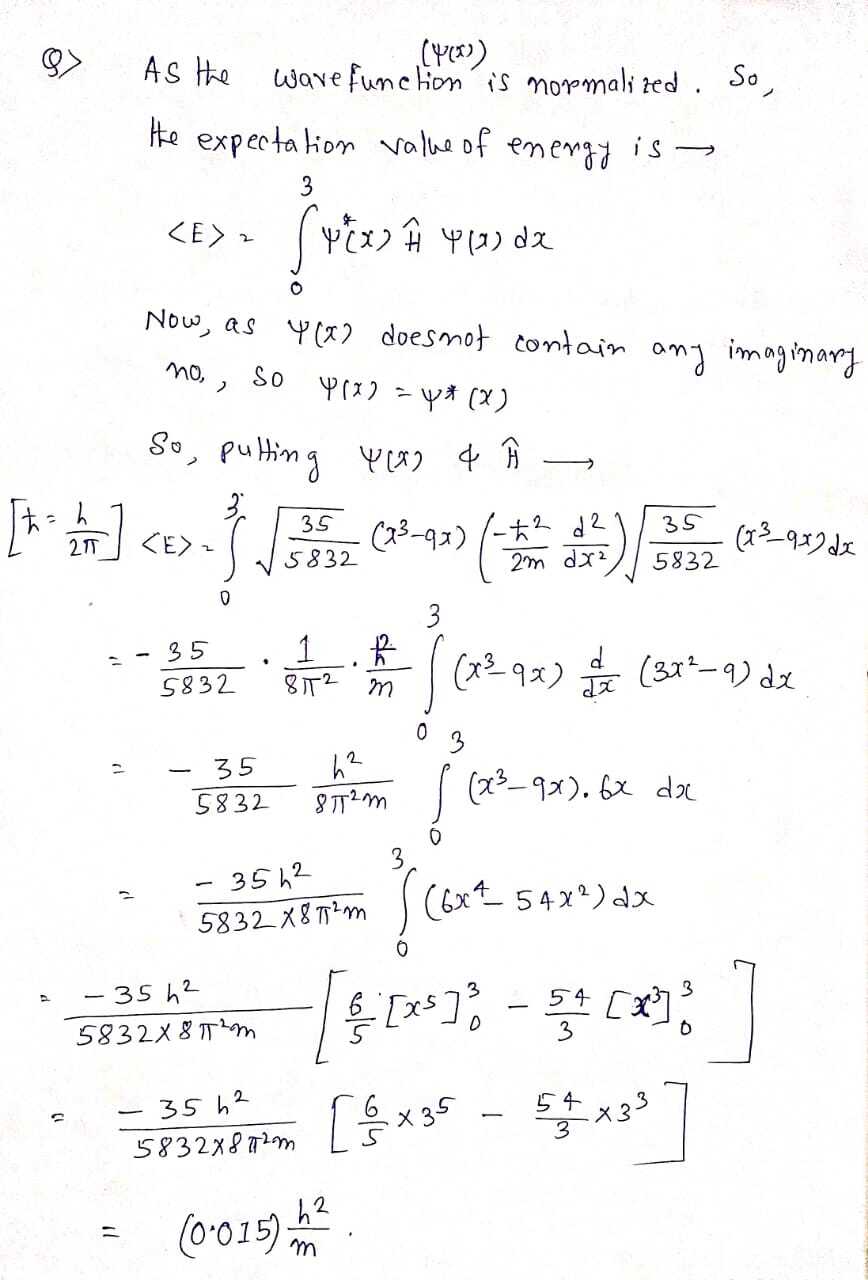Consider a 1D particle in a box confined between z = 0 and z = 3. The Hamiltonian for the particle inside the box is simply given by Ĥ *4 Consider the following normalized wavefunction 2m dr²° ¥(x) = / (x³ – 9x). Find the expectation value for the energy of the particle inside the box. Give your 35 3832 final answer for the expectation value in units of (NOTE: h, not hbar!). In your work, compare the expectation value to the lowest energy state of the 1D particle in a box and comment on how the expectation value you calculated for the wavefunction ¥(x) is an example of the variational principle.
Consider a 1D particle in a box confined between z = 0 and z = 3. The Hamiltonian for the particle inside the box is simply given by Ĥ *4 Consider the following normalized wavefunction 2m dr²° ¥(x) = / (x³ – 9x). Find the expectation value for the energy of the particle inside the box. Give your 35 3832 final answer for the expectation value in units of (NOTE: h, not hbar!). In your work, compare the expectation value to the lowest energy state of the 1D particle in a box and comment on how the expectation value you calculated for the wavefunction ¥(x) is an example of the variational principle.
Principles of Modern Chemistry
8th Edition
ISBN:9781305079113
Author:David W. Oxtoby, H. Pat Gillis, Laurie J. Butler
Publisher:David W. Oxtoby, H. Pat Gillis, Laurie J. Butler
Chapter4: Introduction To Quantum Mechanics
Section: Chapter Questions
Problem 42P
Related questions
Question

Transcribed Image Text:Consider a 1D particle in a box confined between a = 0 and x = 3. The Hamiltonian for the particle inside the
box is simply given by Ĥ
. Consider the following normalized wavefunction
2m dz²
¥(2) =
35
(x³ – 9x). Find the expectation value for the energy of the particle inside the box. Give your
5832
final answer for the expectation value in units of (NOTE: h, not hbar!). In your work, compare the expectation
value to the lowest energy state of the 1D particle in a box and comment on how the expectation value you
calculated for the wavefunction ¥(x) is an example of the variational principle.
Expert Solution
Step 1

Trending now
This is a popular solution!
Step by step
Solved in 2 steps with 2 images

Knowledge Booster
Learn more about
Need a deep-dive on the concept behind this application? Look no further. Learn more about this topic, chemistry and related others by exploring similar questions and additional content below.Recommended textbooks for you

Principles of Modern Chemistry
Chemistry
ISBN:
9781305079113
Author:
David W. Oxtoby, H. Pat Gillis, Laurie J. Butler
Publisher:
Cengage Learning

Physical Chemistry
Chemistry
ISBN:
9781133958437
Author:
Ball, David W. (david Warren), BAER, Tomas
Publisher:
Wadsworth Cengage Learning,

Introductory Chemistry: A Foundation
Chemistry
ISBN:
9781337399425
Author:
Steven S. Zumdahl, Donald J. DeCoste
Publisher:
Cengage Learning

Principles of Modern Chemistry
Chemistry
ISBN:
9781305079113
Author:
David W. Oxtoby, H. Pat Gillis, Laurie J. Butler
Publisher:
Cengage Learning

Physical Chemistry
Chemistry
ISBN:
9781133958437
Author:
Ball, David W. (david Warren), BAER, Tomas
Publisher:
Wadsworth Cengage Learning,

Introductory Chemistry: A Foundation
Chemistry
ISBN:
9781337399425
Author:
Steven S. Zumdahl, Donald J. DeCoste
Publisher:
Cengage Learning

Chemistry: Principles and Practice
Chemistry
ISBN:
9780534420123
Author:
Daniel L. Reger, Scott R. Goode, David W. Ball, Edward Mercer
Publisher:
Cengage Learning

Principles of Instrumental Analysis
Chemistry
ISBN:
9781305577213
Author:
Douglas A. Skoog, F. James Holler, Stanley R. Crouch
Publisher:
Cengage Learning